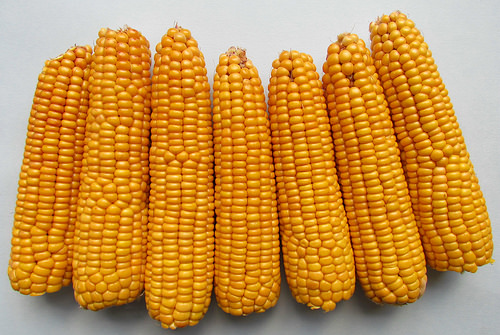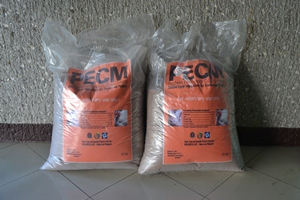Corn is the second largest planted crop next to rice, of which 66% is yellow corn (YC). Around 90% of YC is used as feeds for livestock and poultry. It accounts for 50-60% of a typical mixed feed. The YC is one of the indispensable inputs to swine and poultry production providing livelihood to around 1.5 million corn farmers.

Yellow corn is one of the most important feed grains in feed milling. Photo from the Livestock Research Division
An equally important feed resource of the Philippines is copra meal, which is primarily being utilized as animal feed. As the top producer of copra in the world, the Philippines in 2014 produced about 750,000 metric tons of copra meal as coconut by-product. About 60% of this was locally utilized mainly as animal feed. Like soybean meal, copra meal is technically classified as a plant-based protein feed ingredient and mainly used as source of protein and energy in mixed feed.
Cognizant of the importance of yellow corn and copra meal as major feed materials for the livestock and aqua sectors, the Philippine Council for Agriculture, Aquatic and Natural Resources Research and Development of the Department of Science and Technology (DOST-PCAARRD) supported research and development (R&D) programs under the feed resources Industry Strategic Science and Technology (S&T) Program (ISP).
As low productivity is one of the major gaps in corn production, S&T intervention was focused on increasing yield per hectare and on developing corn varieties and hybrids with high protein content and biofertilizers to enhance corn production. To address the issue on high cost and ensuring quality of animal feeds, R&D programs were also focused on improving the nutritive quality of copra meal and developing Near Infrared (NIR) spectroscopy instrument.
Feed resources ISP accomplishments
Breeding of yellow Quality Protein Maize (QPM) is a technology option to address the present very low average yield. High yielding and stable QPM hybrids complemented with optimum planting density, level of fertilization, and economic advantage over traditional YC varieties is being developed collaboratively by University of Southern Mindanao (USM), Central Mindanao University (CMU), and Central Luzon State University (CLSU). At the moment, two potential QPM hybrids are being evaluated for dry and wet season trials. The QPM management practices, particularly planting density and fertilizer requirement optimization as well as proper storage, are also being assessed.
Reduction in the use of inorganic fertilizer up to 50%, which lessens the fertilization cost up to 25%, is realized with the use of enhanced biofertilizer for corn (Mykoplus) developed by University of the Philippines Los Baños (UPLB).
Bioprocessing technology or the solid state fermentation process to improve the quality of copra meal into protein enriched copra meal (PECM) was developed by UPLB. The technology has improved the overall nutritive value of copra meal and the process has enabled 92-96% product recovery rate.

Protein enriched copra meal (PECM) developed by UPLB for swine and poultry (Photo from the Livestock Research Division, DOST-PCAARRD)
PECM is considered as a new protein feed ingredient primarily intended for swine and poultry, and aqua species. Positive results were observed in swine and poultry given mixed feed with PECM. Initial trials in tilapia, milkfish, and shrimp showed promising results in reducing feed cost.
PECM can partially substitute the imported soybean oil meal (SBOM), fish meal, and other protein feed ingredient used in manufacturing feeds of swine, poultry, tilapia, milk fish, and shrimp. SBOM is 100% imported and expensive; hence reducing its use would mean savings on dollar reserves while decreasing dependence on SBOM.
The inconsistent nutrient composition of feed ingredients has been always a consistent predicament in animal and aqua feed manufacturing. Hence, the Cavite State University (CvSU) developed a locally manufactured NIR spectroscopy instrument to ensure quality of YC and other feed material at cheaper prices.
Realization of these S&T interventions would certainly contribute to security of inputs needed to sustain the local livestock and aqua industries.
DOST-PCAARRD will showcase feed resources including other science and technology (S&T) agri-aqua research and development (R&D) outputs on March 2-4, 2016 during the SIPAG FIESTA at its headquarters in Los Baños, Laguna.
SIPAG, a technology transfer strategy, embodies the Council’s commitment to DOST’s Outcome One in a bid to ensure that the fruits of R&D activities for the agri-aqua sectors will be a blessing for every Juan.
by Livestock Research Division, DOST-PCAARRD S&T Media Service

